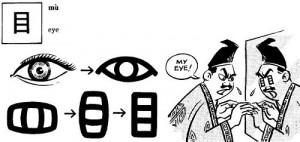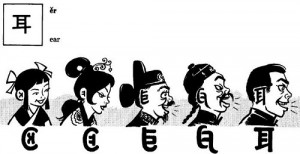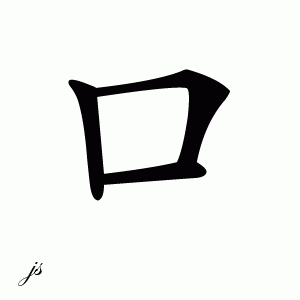What’s in a Chinese Character? (Vol. 2) Posted by sasha on Mar 3, 2012 in Culture, Vocabulary
It’s been a while since we talked about Chinese characters (find Vol. 1 here), so let’s look at a few more examples. Last time, we looked at the character for person (人 – rén), so now let’s take a closer look at a person.
Take a look in the mirror at your beautiful face (面 – miàn). This character has evolved over time, beginning with a basic drawing of a human face. It also has a few other meanings, including “noodle” and “surface.” In Chinese culture, the concept of “face” – basically meaning dignity or prestige – is huge. “Losing face” (丢面子 – diū miàn zi) is a terrible thing, and this happens when you’re embarrassed or humiliated, when you lose, when you’re criticized in front of others, and so on.
The reason you’re able to see your lovely face in the mirror, of course, is your eyes (目 – mù). The earliest form of this character clearly showed an eye, and over time it lost its curves and was turned on its side. It’s also used as a radical in many other characters having to do with sight, such as: look (看 – kàn), wink (眨 – zhǎ), and TV program (电视节目 – diàn shì jié mù).
Similarly, the character for ear (耳 – Ěr) also evolved from a pictograph, becoming more stylized over time. This too is used as a radical, in characters having to do with hearing. Some examples include: headphones (耳机 – ěr jī – lit. “ear machine”), chat (聊 – liáo), and whisper (耳语 – ěr yǔ).
Perhaps one of the easiest Chinese characters to learn is the one for mouth (口 – kǒu) – it’s simply a box that looks like an open mouth. It’s used in other words, such as entrance (入口 – rù kǒu) and exit (出口 – chū kǒu). Not surprisingly, it’s also a radical, and it’s used in characters having to do with the mouth, such as to call (叫 – jiào), to recite/chant (唪 – fěng), and even the word suck (吮 – shǔn). And if you’re not down with Chinese, I’ve got two characters for you – 吮它!
Next up, let’s look at the character for hand (手 – shǒu). It kind of looks like a hand, right? You’ll often see this character in restaurants, as some items are touted as “hand-made” (手工 – shǒu gōng). Since a chef uses his hands so much to tear vegetables, they can be described as “hand-torn” (手撕 – shǒu sī). Look closely at the character for I/me (我 – wǒ). It’s a hand (手) holding a spear (戈 – gē) – a clear symbol of ego assertion. It should be noted that the mirror image of 手 is 毛 (máo), as in Chairman Mao. In a restaurant, you might see “Chairman Mao’s red-cooked pork” (毛氏紅燒肉 – máo shì hóng shāo ròu), which was his favorite dish.
We know the character for person, but what happens when you put two people together? Well, one person follows another while they go from (从 – cóng) one place to another. Do you see it? 人 + 人 = 从. With thousands upon thousands of Chinese characters out there, think of all the fun you can have learning about them all!

Build vocabulary, practice pronunciation, and more with Transparent Language Online. Available anytime, anywhere, on any device.
About the Author: sasha
Sasha is an English teacher, writer, photographer, and videographer from the great state of Michigan. Upon graduating from Michigan State University, he moved to China and spent 5+ years living, working, studying, and traveling there. He also studied Indonesian Language & Culture in Bali for a year. He and his wife run the travel blog Grateful Gypsies, and they're currently trying the digital nomad lifestyle across Latin America.










Comments:
Martin:
EXCELLENT!! I am really looking forward to future volumes